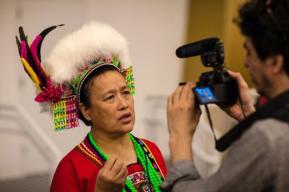News
Digital preservation of Indigenous languages: At the intersection of technology and culture

The Missing Scripts started from the alarming realization that nearly half of the world's writings remain absent from digital platforms. Among these are not only ancient scripts, some of which remain undeciphered, but also a large number of minority or Indigenous writings still in use today. Neglected by the digital industry, these writings, along with the languages they represent face the threat of extinction. How can we fix this situation? The initial step involves encoding these scripts, a process that entails standardizing them by assigning a numerical identifier to each symbol.
This crucial task has been carried out by the Universal Unicode Standard since the early 1990s. However, mere encoding is insufficient. Equally imperative is the development of input methods such as keyboards to ensure compatibility across various operating systems, as well as the creation of appropriate fonts. Designing these “digital fonts” requires specialized expertise, involving collaboration with experts, including linguists, developers and native speakers. This is the mission led by the Atelier national de recherche typographique (ANRT), housed in a public art school, to allow these writings to be accessible on computers and smartphones. This approach thus makes a strong case for an interdisciplinary artistic education that combines technology, art, culture and typography.
This is an essential issue of digital empowerment. Without proper encoding, not only is the publication or exchange of texts is impossible, but also the construction of vital datasets essential to current technologies, such as automatic translation, voice recognition, machine learning and AI becomes unattainable. It was therefore a natural progression for The Missing Scripts project to join hands with the International Decade of Indigenous Languages, to draw global attention to the plight faced by numerous Indigenous languages. The Global Action Plan for the International Decade of Indigenous Languages provides enabling conditions for digital empowerment, access to information and language technologies, and artistic creation in Indigenous languages. In this context, The Missing Scripts project fits seamlessly with the proposed outputs in the Global Action Plan, contributing to the goal of enhancing the practical use of Indigenous languages.
On 14 February 2024, the event “Digital Arts and Cultural Inclusion: Navigating the Intersection of Technology, Identity and Dialogue” took place alongside the thematic sessions of the the UNESCO World Conference on Cultural and Arts Education (WCCAE). The speakers presented various initiatives in artistic education and digital creation focused on intangible heritage. Among them, Thomas Huot-Marchand, Director of the ANRT, presented the International Decade of Indigenous Languages, and spotlighted the work of the ANRT, a laboratory of the National School of Art and Design of Nancy, France. Founded in 1985, the ANRT welcomes student researchers from all over the world every year. One of its flagship programs, The Missing Scripts, has been developed in partnership with the Script Encoding Initiative (University of California, Berkeley) and the University of Applied Sciences Mainz (Germany) since 2016.
From 13 to 15 February 2024, the UNESCO World Conference on Cultural and Arts Education was held at the National Exhibition Center in Abu Dhabi, United Arab Emirates. The event brought together nearly 1,000 culture and education stakeholders, including 90 ministers and 125 representatives from UNESCO's member states. At the closing of the conference, UNESCO Member States unanimously adopted a new Global Framework for Cultural and Arts Education. Notably, this framework prioritizes the enhanced promotion and preservation of Indigenous heritage and cultures.







